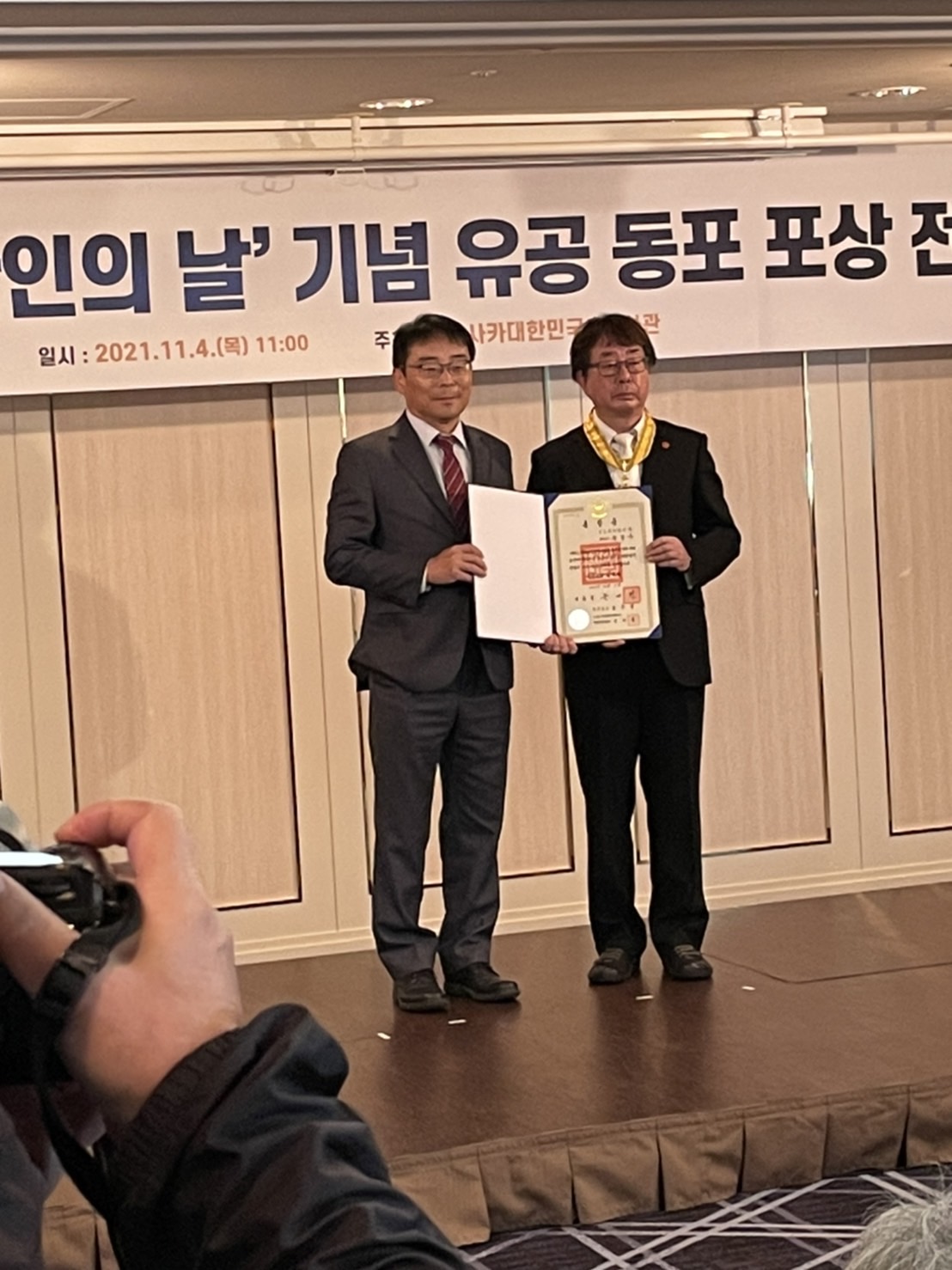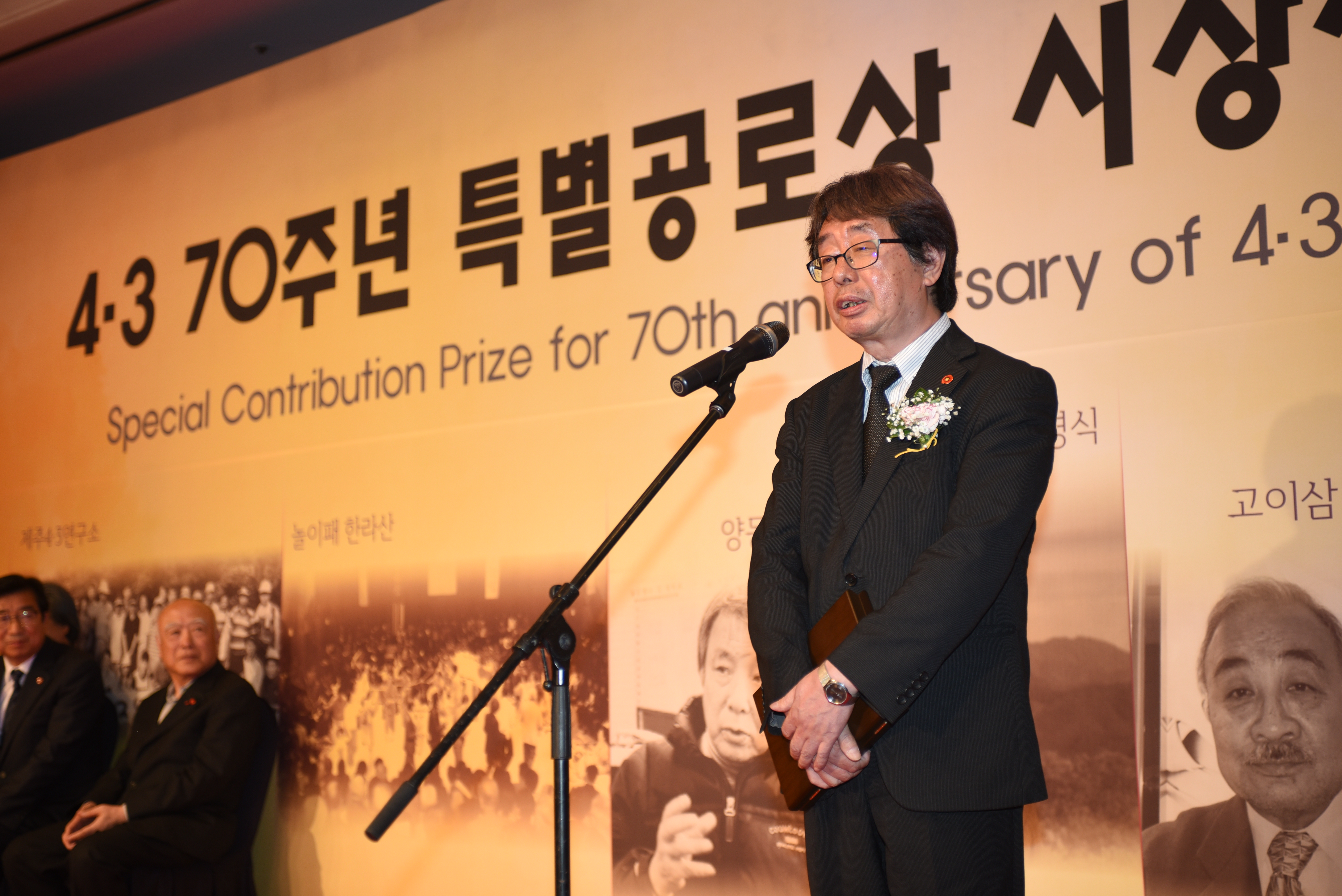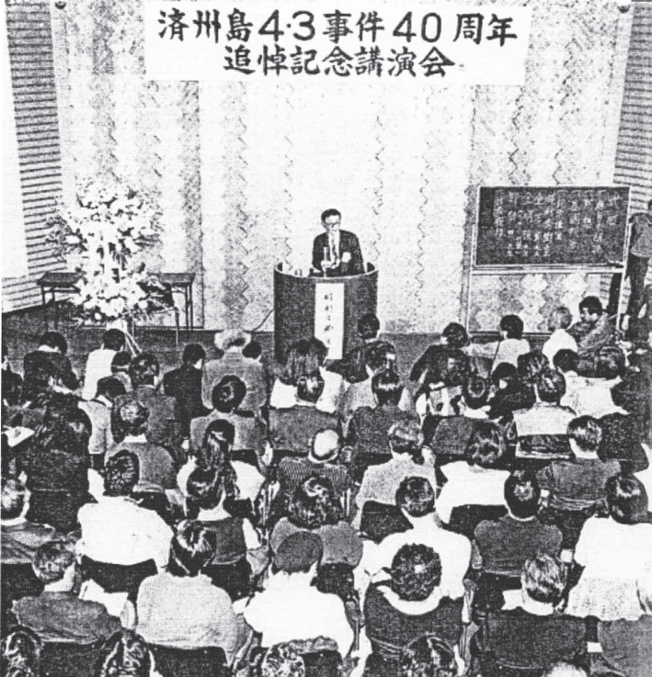Publicizing the value found in the marginal areas of Jeju 4·3
Mun Gyong-su
Mun Gyong-su (aged 71) is a professor emeritus at Ritsumeikan University who was born in 1950 in Mikawashima of Arakawa, a special ward located in the Tokyo Metropolitan Area of Japan. As a second-generation Zainichi Korean — Zainichi Koreans are ethnic Koreans residing in Japan who emigrated from Korea around the Japanese colonial period or who are their descendants — the scholar has made a strenuous effort to reveal the truth of Jeju 4·3 and restore the honor of the victims and their family members. Together with novelists Kim Sok-pom, Hyun Kwang-su, and Kim Min-ju, Mun founded the Association of Korean Residents in Japan Remembering Jeju 4·3 in 1987 in Japan, and the following year, that group of people led the hosting of the Memorial Lecture Commemorating the 40th Anniversary of Jeju 4·3, which was the first Jeju 4·3-related event held in Tokyo. Mun later served as the chairman of the Tokyo and Osaka branches of the association, and was involved in the various memorial projects in both regions. In recognition of his contributions to commemorating and publicizing the Jeju 4·3 issues in Japan, he was awarded the Special Achievement Prize (For Overseas Activities) by the Jeju 4·3 Peace Foundation in 2018, on the 70th anniversary of Jeju 4·3. In November 2021, the South Korean government selected Mun as the winner of the Dongbaek [Camellia] Medal, the third class of the nation’s Order of Civil Merit, marking the 15th World Korean Day. We interviewed Mun, wondering what he thought about the time he had spent with other Zainichi Koreans, who share the same identity with him and are called the “Jeju diaspora” and “marginal people” due to Jeju 4·3. — Editor

Mun poses for a commemorative photo in November 2021 after receiving the Camellia Medal (Order of Civil Merit) during the World Korean Day event.
This year, on the 15th World Korean Day, you were selected as a recipient of a government award for merit and received the Camellia Medal, a National Order of Merit. Congratulations. I would like to hear your impressions.
It is my great honor and I sincerely thank those others who have also engaged in various activities and research, including the Jeju 4·3 movement. Last year, the same award was presented to Oh Kwang-hyeon, chairman of the Japan Association of the Bereaved Families of Jeju 4·3 Victims, who has worked with me for the Jeju 4·3 movement in Osaka. It is a thing to be grateful for that the South Korean government gives recognition to the Jeju 4·3 movement in Japan. However, thinking about the past when we maintained a tense relationship with the Korean government because we were involved in the Jeju 4·3 movement, I am also amazed at how much things have changed.
I grew up in the Jeju community in Tokyo and was educated at the “Chosen Gakko,” an institution affiliated with the so-called Chongryon [the General Association of Korean Residents in Japan]. My longing for Jeju as my hometown is much greater than my sense of belonging to South Korea. At the medal award ceremony hosted by the Consulate General of South Korea in Osaka, I didn’t express my loyalty to the country. Rather, I said that I would strive to believe in the ideology and value of democracy engraved in the country’s Constitution.
The latest award is regarded as the result of evaluation and recognition of the Jeju 4·3 movement in Japan. What has Jeju 4·3 meant to Japanese society, especially to Zainichi Koreans?
On Aug. 15, 1945, an innumerable number of Jeju-born Koreans experienced national liberation from Japan while staying in Japan. Many of those who returned to their homeland migrated again to Osaka or other regions in Japan during the period of extreme chaos around Jeju 4·3. After World War II, the General Headquarters of the Allied Powers in Japan strictly prohibited the re-entry of Koreans who had returned to Korea. So, during this period, Koreans migrating to Japan had no choice but to do so by means of “stowing away” on boats.
I estimate that the number of Koreans who settled in Japan after national liberation reached around 0.6 million, of which 80,000 were from Jeju, with 10,000-20,000 of those being Jeju locals who had arrived via boat due to Jeju 4·3. Including the stowaways and their family members and acquaintances, the Jeju people residing in Japan at the time were related to Jeju 4·3 to some extent.
However, Japan had a strong atmosphere of treating Jeju 4·3 as a taboo topic which was almost equal to that in South Korea. As is well known, there are two groups of Koreans in Japan: Chongryon and the Republic of Korean Residents Union in Japan, or Mindan. Not only Mindan, which supports the South Korean government, but also the pro-North Korean Chongryon tended to be reluctant to mention Jeju 4·3 until the 1970s. Perhaps it was because the perception that the 1948 uprising was led by the South Korean Labor Party (SKLP) was intertwined with the traditional sense of regional discrimination. There was also the extreme avoidance of anything related to politics, excessive loyalty to power, and thorough obsession with money and property, and more. Now that I think about it, this might have been the expression of the frustration or psychological refraction of those Jeju people who had suffered the infernal Jeju 4·3. In my case as well, I became aware of the Jeju 4·3 issues only after coming across Kim Sok-pom’s novel “The Death of the Crow” and media reports in the 1970s.

Mun gives an acceptance speech in April 2018 for the Special Achievement Prize presented by the Jeju 4·3 Peace Foundation.
You have led the Jeju 4·3 movement in Japan over the past 30 years. Could you briefly introduce the movement?
The Jeju 4·3 movement in Japan started in earnest with the commemorative event in Tokyo, which was held in 1988, on the 40th anniversary of Jeju 4·3. But at the time, I participated in the secretariat only as an assistant. Joining Kyoto Ritsumeikan University in 1994, I began my direct involvement in the Jeju 4·3 movement in Osaka and Tokyo. The most memorable event so far has been the 50th anniversary memorial ceremony in 1998. In Tokyo, novelist Kim Sok-pom, representative Cho Dong-hyun of the Tokyo branch of the Association of Korean Residents in Japan Remembering Jeju 4·3, and CEO Ko I-sam of the Shinkansha publishing house organized various large-scale performances and hosted a guest lecture by Bruce Cumings, a professor at the University of Chicago. The Osaka members, including late former chairman Kang Shil of the association and chairman Oh Kwang-hyeon of the Japan Association of the Bereaved Families of Jeju 4·3 Victims, invited Kim Yun-su, a Jeju shimbang [shaman] designated as a Korean human cultural asset, and held the Haewonsangsaeng Gut [a spiritual ritual ceremony] to appease the souls of the Jeju 4·3 victims. The Tokyo event contributed greatly to publicizing the Jeju 4·3 issues in Japan, and the Osaka memorial ceremony provided an opportunity for the first-generation descendants of Jeju-born migrants and the generation who had experienced Jeju 4·3 to collectively lead the Jeju 4·3 movement.
Other memorable events include the 56th and the 60th anniversary events. The former was jointly held by the Tokyo and Osaka Steering Committees, while a group of 200 people visited Jeju for the latter event. Particularly, the 56th anniversary event of 2004 was attended by the executives from the Mindan and the Chongryon, although the individual participants did not represent the groups. This created momentum for inter-Korean reconciliation through Jeju 4·3 to emerge as a major issue in the Jeju 4·3 movement in Japan. And in 2018, on the 70th anniversary, we erected the Memorial Monument for the Jeju 4·3 Victims at the Tokokuji Buddhist Temple in Osaka.

The Memorial Lecture Commemorating the 40th Anniversary of Jeju 4·3 is held in Tokyo in 1988.
How would you evaluate the Jeju 4·3 movement in Japan?
In 2002, the Jeju 4·3 Committee under the South Korean government decided to exclude the heads of the “armed resistance forces” (leaders of the April 3 uprising) and the heads of the SKLP (leaders of the resistance movement following the uprising) from the category to be recognized as Jeju 4·3 victims. Those who had arrived via boat as stowaways from Jeju to Japan included a considerable number of people who were involved in the “resistance leadership”, and most of them have lived in Japan as members of Chongryon-affiliated (pro-North Korean) circles. The criteria for recognition of Jeju 4·3 victims determined by the Jeju 4·3 Committee is a denial of these people, and it goes against the spirit of inter-Korean reconciliation. From this perspective, we have led the Jeju 4·3 movement in Japan, where those from the “South” and from the “North” share the same living space, under the slogan of “restoration of honor to all Jeju 4·3 victims”. It is true that the Jeju 4·3 movement contributed greatly to publicizing the Jeju 4·3 issues in Japan. Now, not only the Zainichi Korean society but also the Japanese civil society says that “If you don’t know about Jeju 4·3, you cannot describe Korean history or society.” In Osaka, the third and fourth-generation Zainichi Koreans hold an ongoing learning session on the topic of Jeju 4·3, together with young Japanese people. While the existing national movements led by the Chongryon and the Mindan have lost their strength, the Jeju 4·3 movement is supported as a “movement to achieve historical justice”.
However, it is also true that in some cases, discrimination against Zainichi Koreans based on hatred of Korea or racism has intensified due to the influence of historical revisionism that has emerged in the Japanese society since the late 1990s. Regarding Jeju 4·3, we still see the activities of spreading false perceptions on social media that it is an “incident that showcases the cruelty of Koreans” or that “all Zainichi Koreans are descendants of illegal stowaways.”
While engaging in the Jeju 4·3 movement, you have conducted various research and writing activities on Jeju 4·3 at your university. Could you tell us about your Jeju 4·3 research?
As a social sciences major in college, I came across many books by J. Habermas and H. Arendt. Naturally, I came to think of Jeju 4·3 in the framework of “civil society” and “arenas of public debate”. For instance, Arendt conceived the “form of ruling” created during the transitional turbulence of political society as a ruling system which is based on nothing other than the people’s impulse to organize themselves. I considered the People’s Committee, which was autonomously organized on Jeju immediately after national liberation, as that system of ruling. On Jeju, such an arena of public debate was destroyed due to Jeju 4·3, and was regenerated after the June democratization movement in the 1980s through voluntary objections and communication from Jeju residents over the Special Act on Jeju-do Development in the early 1990s. This is the main idea of my doctoral dissertation. I am not a nationalist. So, rather than viewing the April 3 armed uprising as a “unification movement”, I put more weight on the aspect of a “self-defensive counterattack against the tyranny of the United States Military Government, which put the police and the right wing at the forefront of suppressing the Jeju communities”.

The posters promote the Memorial Concert Marking the 50th Anniversary of Jeju 4·3 and the Memorial Folk Gut Ceremony Commemorating the 56th Anniversary of Jeju 4·3 in Tokyo.
The Jeju 4·3 Special Act was revised 20 years after its legislation. How would you rate the revised act?
The passage of the amendment to the Jeju 4·3 Special Act is also widely welcomed in Japan. The revised act will include important clauses concerning the collective retrials for the unlawfully convicted victims, the operation of the Jeju 4·3 Trauma Center, and the ensuing investigation of the truth of Jeju 4·3. Above all, it is particularly a welcoming feature that the “special provision of support including consolation money, etc.” will be made as a “compensation” for the damage to the victims.
I have watched the deliberation process of the bill since late in 2017 when Rep. Oh Young-hun proposed the general amendment bill of the Jeju 4·3 Special Act at the National Assembly. What I paid attention to was the clause on the definition of Jeju 4·3 and the provisions that stipulate compensation and indemnification. As is well known, the previous definition of Jeju 4·3 before the revision was mostly confined to the description of the period. However, in the bill proposed in 2017, the definition contains the expression “the resistance of Jeju residents against the suppression by the police and the Northwest Youth League”. This clause, together with the clause on the ensuing investigation of the truth, would pave the road for the redefinition of Jeju 4·3, or the so-called “proper naming” issue. However, the adopted bill on the general revision of Jeju 4·3 revealed that not a single word or expression has changed in the definition of Jeju 4·3 from the existing Jeju 4·3 Special Act. It is very unfortunate.
As for “compensation”, I have heard that the movement is distorted or failed when “compensation” is brought up to resolve the wrongful past issues. But I disagree. Considering the immeasurable damage to Jeju residents due to Jeju 4·3 and the subsequent social discrimination they suffered under the anti-communist regime, such as the false accusation of “rioters” and the system of guilt by association, compensation is considered a justifiable measure. The only issue is who to be recognized as victims or their inheritors who will be subject to compensation.
From my standpoint of engaging in the Jeju 4·3 movement in Japan, I have many questions about whether compensation is limited to the formerly recognized victims that exclude the “leaders of the resistance”. I am also curious about what will happen when a victim’s bereaved family member with “North Korean” or “Japanese” nationality applies for compensation. One thing I find unfortunate about this issue is that according to the announcement by the Ministry of the Interior and Safety made in October 2021, several expert consultations and meetings were held to determine the contents of “compensation”, yet not a single meeting was held in Japan to gather opinions and ideas.

People sit in front of the Memorial Monument for the Jeju 4·3 Victims at the Tokokuji Buddhist Temple, Osaka, for the annual April memorial ceremony.
Lastly, I would like to hear from you about your plans for the future.
Currently, I serve as a member of the Steering Committee for Jeju 4·3 projects in Japan. The Osaka memorial ceremony for the Jeju 4·3 victims has been held at Tokokuji Buddhist Temple since we erected the Memorial Monument for the Jeju 4·3 Victims there in 2018. Starting two years ago due to the COVID-19 pandemic, we hold the on-site memorial event with a limited number of people and instead broadcast the ceremony live online. We are still discussing how to organize the 74th anniversary event. We hold the Steering Committee meeting in person or online about once a month, continuing our regular activities. As I mentioned earlier, the young generation in Japan is affiliated with the Steering Committee, and we regularly hold independent research meetings with 20 to 30 people attending. In addition, we promote a joint editing and writing project in order to publish a book titled “Jeju 4·3 for Adolescents” in 2022.
Up until the 70th anniversary, we carried out various projects in close cooperation with the Jeju-based organizations related to Jeju 4·3, such as the Jeju 4·3 Peace Foundation. However, it is true that the COVID-19 situation has been shrinking our interaction and solidarity. But I recently heard that an association of Jeju 4·3 victims’ families was created in the United States. I expect that when the “with COVID” system is settled, we’ll be able to more actively promote international solidarity centered on Jeju.
Personally, I published a book titled “South Korea in the Moon Jae-in Era: Democracy of Mourning (Japanese: 《文在寅時代の韓国:弔いの民主主義》) in November 2020. The book describes how the absolutely personal emotion of “mourning” became politicized through the medium of diverse and active communication, and provided the driving force for democratization pursuing the eradication of “deep-rooted evils”. It appears that my long experience of being involved in the memorial events for the Jeju 4·3 victims provided the source of my idea of linking mourning and politics. In the coming year, I plan to author a sequel to this book.